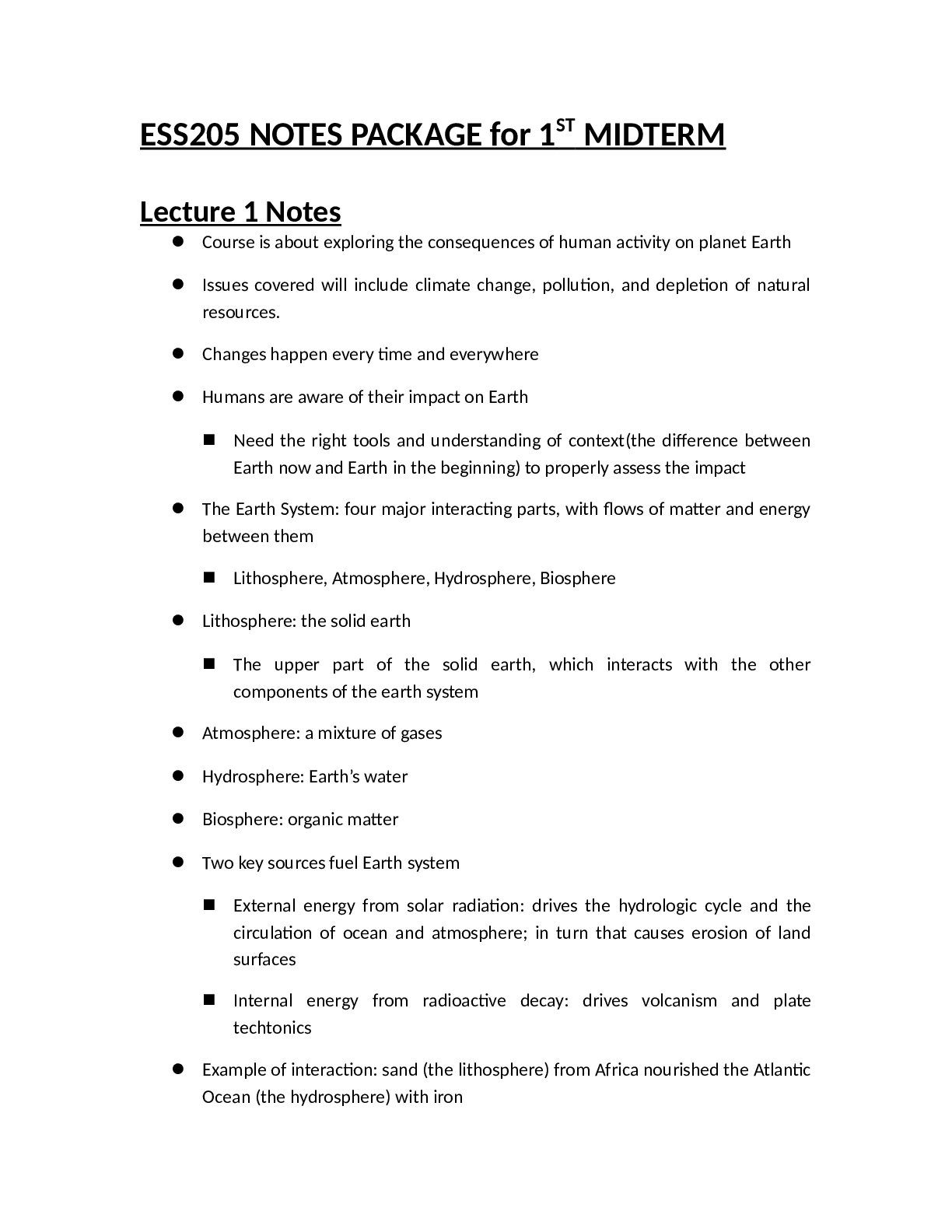Lecture 1 Notes
Course is about exploring the consequences of human activity on planet Earth
Issues covered will include climate change, pollution, and depletion of natural
resources.
Changes happen every time and everywhere
Humans are aware of their impact on Earth
Need the right tools and understanding of context(the difference between
Earth now and Earth in the beginning) to properly assess the impact
The Earth System: four major interacting parts, with flows of matter and energy
between them
Lithosphere, Atmosphere, Hydrosphere, Biosphere
Lithosphere: the solid earth
The upper part of the solid earth, which interacts with the other
components of the earth system
Atmosphere: a mixture of gases
Hydrosphere: Earth’s water
Biosphere: organic matter
Two key sources fuel Earth system
External energy from solar radiation: drives the hydrologic cycle and the
circulation of ocean and atmosphere; in turn that causes erosion of land
surfaces
Internal energy from radioactive decay: drives volcanism and plate
techtonics
Example of interaction: sand (the lithosphere) from Africa nourished the Atlantic
Ocean (the hydrosphere) with iron
Global Change: the modification of the Earth’s components and of the
interactions between the components, both natural and human-induced
Change is a typical characteristic of Earth
Types of change
Gradual: takes place over long period of time
Catastrophic: takes places rapidly
Unidirectional: Harry Styles (evolution)
Cyclic: supercontinental cycle, sea-level cycle, glacial-interglacial cycle
Beginning of time: universe was created from the Big Bang
Small, dense collection of matter and energy suddenly exploded
Evolution of Earth can be divided into stages known as eons and eras
Hadean Eon: oldest time as we know it (4.6 to 3.8 billion years ago)
“Hell on Earth”: Earth very hot, chemicals forming, no oxygen,
Internal Differentiation: much radioactive decay and the molten state of
Earth led to heavier elements such as iron and nickel settling down in the
Earth’s core
Conditions at Surface: magma ocean at first, thin crust as Earth cooled,
atmosphere formed except without oxygen yet
Archean Eon: (3.8 to 2.5 billion years ago)
Water and oceans appear
Intense greenhouse effect
Carbon cycle: made Earth hospitable
First evidence of life appears about 3.8 billion years ago from rocks in
Greenland, photosynthesis occurs 2.4 billion years ago to first release
oxygen!
Proterozoic Eon (2.5 to 0.55 billion years ago)
Large volume of iron
Eurkaryotic (multi-cellular) cells appear, exponentially increasing oxygen in
the atmosphere and ocean
Small invertebrates
Phanerozoic Eon (545 million years ago to present)
Visible life (ie animals, plants, humans, etc.)
Lecture end around this time
Lecture 2
THE CENOZOIC ERA (65 Ma – present)
Recap
2.5 : enough oxygen in the atmosphere to have an ozone layer
Proterozoic : low oxygen atmosphere but an ozone layer – so life is now
protected from dangerous UV layers \
Evolution of periotic cells – photosynthesis good at converting energy from the
sun
Evolution of multi-cellular life
What was major change in this period?
Paelozoic – major animal groups evolve
Anphibeans, fish and reptiles all evolving
Warm in-land seas
Relatively warm period
Around 400 – 450 evolution of land plants – so surface of planet changes
dramatically
All the continents forming all Pangea
End of this : largest extinction
Pangea breaks apart then Mesozoic – age of dinos and reptiles
Extreme warmth on the planet
End of Mesozoic – another extinction – meteor?
Caenozoic: today
The Cenozoic Era (65 Ma – present)
The era we live in
It started off warm with no ice or no permanent ice sheets
Read More


